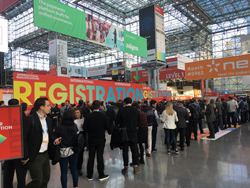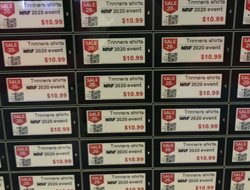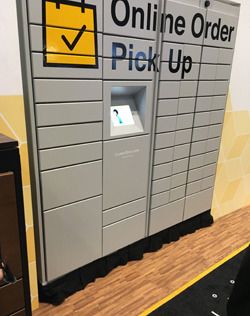- Categories:
Bibliotech: A Visit to the National Retail Federation’s 2020 Trade Show
As part of a new regular column on technology in the bookselling world, here Director of ABA Technology Greg Galloway offers a look at some of the newest technology and tools coming soon to retailers.
 Last month, IndieCommerce Director Phil Davies and I spent a day prowling the aisles of the behemoth retail trade show NRF 2020 Vision: Retail’s Big Show. Spanning four floors of New York City’s Jacob K. Javits Convention Center, NRF 2020 Vision included more than 800 vendors promoting their latest, new-and-improved tools for retail success. Phil and I were there looking for tools that might help ABA member bookstores and to try to spot the cutting-edge retail trends that will become commonplace before we all know it. By the time our prowl had decayed into a crawl, we felt pretty confident that we knew what NRF 2020 wanted us to know.
Last month, IndieCommerce Director Phil Davies and I spent a day prowling the aisles of the behemoth retail trade show NRF 2020 Vision: Retail’s Big Show. Spanning four floors of New York City’s Jacob K. Javits Convention Center, NRF 2020 Vision included more than 800 vendors promoting their latest, new-and-improved tools for retail success. Phil and I were there looking for tools that might help ABA member bookstores and to try to spot the cutting-edge retail trends that will become commonplace before we all know it. By the time our prowl had decayed into a crawl, we felt pretty confident that we knew what NRF 2020 wanted us to know.
Robots. Big retail organizations are going to use robots not just to pick and pack boxes for online orders but also to creep through stores identifying when stock is low or displays are less than perfect. Right now, most of the robots are comically large with big, fat bases and some are also excessively tall, the better to evaluate inventory on even the highest shelf. My local grocery store has one named “Marty,” to which they’ve stuck a set of six-inch googly eyes for friendlification, but it still looks like an old-timey street lamp having a hard time finding the right brand of cat litter after a particularly boozy brunch. I have to admit I saw a four-year-old little lady run enthusiastically up to Marty to give him a hug, so maybe not everyone has the same reaction that I have.
Robots like Marty will certainly get smaller and less awkward, but ideally, they’ll just disappear. Or maybe they’ll become so small and innocuous in appearance that they might as well be invisible. Perhaps we’ll see discreet devices with the profile of a shelf-talker or smoke detector that make the same types of evaluations as Marty. These Stuart-Little-sized bots might instantly alert the right person when neither the spine nor the cover of a book is visible, a big gap had opened up on a shelf, or a helpful cat had pushed everything off a table.

Speaking of shelf-talkers, another item that might hold promise in the near future is the electronic shelf-talker. Sitting on the lip of a shelf and connected to a store’s Wi-Fi network, they use e-ink to display easily read, easily updated messages. While they’ll never outprice paper and ink, they could hold value in their ability to display longer or multiple messages. What if a shelf-talker could cycle through reviews from store staff and a handful of other critical reviews? What if a shelf-talker could alternate between a review and a store’s temporary holiday hours? When the ease of use and price make these feasible for stores of all sizes, I’m sure we’ll see some terrific, creative uses.
One intriguing product that has already sparked some interest for bookstores is the smart lock-box or BOPIS (buy online, pick up in store) locker. A weather- and tamper-proof, ’net-connected locker sitting outside a store or even outside of a store’s neighborhood can serve as a 24-hour concierge for customers who can’t be served during regular opening hours. Having purchased a book online or by phone and having selected after-hours pick up, the customer visits the locker at the time most convenient for them, punches in a code, and retrieves that must-have-now item. Equally, if that must-have-now item turned out to be not-quite-right, the locker can function as an all-hours returns department (following another online or telephonic interaction and some code punching).

The prevailing wisdom in the world of enterprise-level retail is that customers are accustomed to the benefits of personalized interaction and don’t mind sacrificing a bit of privacy to get it. On one extreme of this concept are the many systems promising to identify and track every individual as they enter a store, providing the store with age and gender estimates and a real-time count of people on site. In some cases, the system might provide the specific identity of shoppers, potentially from AI-based services comparing the visitor to publicly available online images. Setting aside the creep factor, these systems, presumably being demonstrated at the top of their game, don’t appear to reliably manage their primary function. Walking in and out of shadow, turning from side to side, or even laughing seemed to stymie these systems’ abilities to guesstimate a passerby’s basic demographics.
As this technology may very likely make its way into more work-a-day systems stores are already using (how long will it be before your security cam system has this built in or available as an add-on?), daydreaming some less creepy uses seems appropriate. Would a customer be excited if a store employee they didn’t know identified them by sight to let them know an item they ordered had arrived? Would an employee closing up alone be happy to know that everyone who had walked into the store had already walked out? Instead of having a Polaroid taped up of a customer who was no longer welcome, would it be good if employees were alerted as soon as that person walked in the door?
Shrinkage. For an independent business, employees can be like family. No one wants to think that a member of their family might be walking out the door with their profits, but, according to a 2019 study by the National Retail Federation, half of all loss from theft is due to employees. New AI-based services help stores to identify exactly when and how that theft is taking place. By analyzing sales, returns, and employee schedules, these services look for patterns to identify exactly when these losses occur (and who was on shift at that moment). With the average shrink rate at 1.38 percent, preventing that sort of loss would be a significant step toward the famed 2% solution.
The bulk of NRF 2020 Vision was aimed at large-scale retail organizations, with plenty on offer for product development, supply chain optimization, and customer analytics. Many of the products and services on display were somewhat out of reach for an independent, Main Street retailer, but that doesn’t make them any less intriguing. Today’s cutting-edge offerings are tomorrow’s commonplace technology. Just as the status symbol of the monster brick cell phone became the ubiquitous smart phone, versions of these technologies will evolve to become accessible, commonplace, and deployed in ways we may not anticipate. It might not be a bad idea to start thinking now about how these tools, fresh out of the white room, will find their way onto Main Street.

